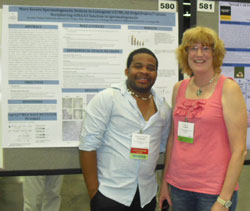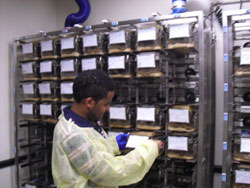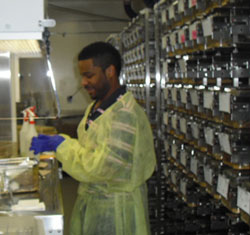Joannes Paulus Yimbesalu
Sigma Xi members can be found across disciplines and fields of academia, government and industry. Each month in Sigma Xi Today, we like to take the time to highlight a different "Fellow Companion," to learn more about their work and what the honor of induction into Sigma Xi has meant for their career.
This issue, we are excited to feature Joannes Paulus Yimbesalu—a Research Technologist II at the Medical College of Wisconsin and an Associate Member of Sigma Xi. Yimbesalu received his Masters degree from New Mexico Highlands University in 2011. A long devoted biologist and humanitarian, Cameroon native Yimbesalu's current work with mice reproductive systems has him positioned at the forefront of research in the expanding field of human infertility.
Tell us about your educational background including your doctoral research, if applicable.
I am originally from Cameroon, one of the western states of sub-Saharan Africa. In 2008, I obtained my Bachelors of Science in Clinical Laboratory Sciences from the University of Buea. I later joined a Malaria Research Laboratory at the same university, where I focused on investigating immunity to malaria and identifying malaria vaccine targets in pregnant women and children. We were funded by the World Health Organization (WHO) and the International Atomic Energy Agency (IAEA). In 2009, I received a scholarship to complete a Masters in Biological Sciences at New Mexico Highlands University (NMHU), where I worked as a graduate assistant for two years. Following graduation, I accepted a position as a Research Technologist II in the department of Microbiology and Molecular Genetics with the Medical College of Wisconsin.
one of the western states of sub-Saharan Africa. In 2008, I obtained my Bachelors of Science in Clinical Laboratory Sciences from the University of Buea. I later joined a Malaria Research Laboratory at the same university, where I focused on investigating immunity to malaria and identifying malaria vaccine targets in pregnant women and children. We were funded by the World Health Organization (WHO) and the International Atomic Energy Agency (IAEA). In 2009, I received a scholarship to complete a Masters in Biological Sciences at New Mexico Highlands University (NMHU), where I worked as a graduate assistant for two years. Following graduation, I accepted a position as a Research Technologist II in the department of Microbiology and Molecular Genetics with the Medical College of Wisconsin.
Do you have a particular teacher or professor who inspired your love of science? Why?
My love for science, especially biology, started back in high school. The professors that have inspired my academic career include my advisor, Dr. Carol Linder, and also Dr. Dick Green, the professor with whom I worked as a teaching assistant while at NMHU. Over the last two years, I have worked in Dr. Linder's lab focusing my work on male infertility. Both of these professors believed in my abilities to succeed in the field of science from the beginning, and have been especially understanding of the challenges one faces when moving into a new environment with a completely different culture.
What is the focus of your current research?
 My main area of research has been in human infertility, using mouse models to identify genes that are known to regulate sperm differentiation. Male infertility accounts for about half of the 15% of couples in western countries experiencing problems conceiving (Feng 2003). Transgenic mouse strains exhibiting infertility have proven to be valuable in helping to decipher underlying mechanisms and pathways involved in human infertility. Most known causes of infertility today include hormonal disorders, genetic mutations, infections, reproductive anatomy trauma and obstruction in the reproductive tract (Zang et al., 1999). Genetic causes have been greatly implicated as a major cause of idiopathic (congenital) male infertility resulting to abnormalities in sperm number, motility and morphology (Lilford et al., 1994). Golga3repro27 mice have a chemically-induced point mutation in the Golga3 gene disrupting spermatogenesis in late meiosis leading to complete infertility with evidence of abnormal spermiogenesis in surviving germ cells. While the females carrying the mutation are reproductively normal, we see a tissue restricted defect in the testes. During my research, I characterized spermatogenesis in the coisogenic C57BL/6J-Golga3repro27 mouse strain to determine if strain background affects the severity of spermatogenetic defects caused by Golga3repro27 prior to spermatogonial stem cell transplantation
My main area of research has been in human infertility, using mouse models to identify genes that are known to regulate sperm differentiation. Male infertility accounts for about half of the 15% of couples in western countries experiencing problems conceiving (Feng 2003). Transgenic mouse strains exhibiting infertility have proven to be valuable in helping to decipher underlying mechanisms and pathways involved in human infertility. Most known causes of infertility today include hormonal disorders, genetic mutations, infections, reproductive anatomy trauma and obstruction in the reproductive tract (Zang et al., 1999). Genetic causes have been greatly implicated as a major cause of idiopathic (congenital) male infertility resulting to abnormalities in sperm number, motility and morphology (Lilford et al., 1994). Golga3repro27 mice have a chemically-induced point mutation in the Golga3 gene disrupting spermatogenesis in late meiosis leading to complete infertility with evidence of abnormal spermiogenesis in surviving germ cells. While the females carrying the mutation are reproductively normal, we see a tissue restricted defect in the testes. During my research, I characterized spermatogenesis in the coisogenic C57BL/6J-Golga3repro27 mouse strain to determine if strain background affects the severity of spermatogenetic defects caused by Golga3repro27 prior to spermatogonial stem cell transplantation
Tell us about something we might see in our daily lives that directly correlates to your work.
Despite the fact that the majority of infertility cases have unknown (idiopathic) origins, most occur as the result of environmental pollutants and lifestyle influences. It is known that certain chemical agents can alter the genetic make-up of cells within the body and this might lead to infertility. In most industrialized countries, facilities like laboratories in the workplace have some exposure levels of radiation materials, despite the fact that there are guidelines established by the public safety department that protect employees.
of infertility cases have unknown (idiopathic) origins, most occur as the result of environmental pollutants and lifestyle influences. It is known that certain chemical agents can alter the genetic make-up of cells within the body and this might lead to infertility. In most industrialized countries, facilities like laboratories in the workplace have some exposure levels of radiation materials, despite the fact that there are guidelines established by the public safety department that protect employees.
Give us an example of how multi-disciplinary research directly contributed to your work.
The advances in the Reproductive Genomics Program of the Jackson Laboratory, a program funded through a grant from the Institute of Child Health and Human Development PO1 HD42137 has provided great insight into genes that regulate spermatogenesis and oogenesis. This program makes use of random chemical mutagenesis of the mouse genome and has so far produced over 100 infertile mouse mutants in the last five years. One of this mutant mouse models is the repro27 mouse model, which I used in this study. As part of this we work, we collaborated with another scientist at Washington State University who helped us with some germ cell transplantation experiments, which involved injecting infertile recipient mice carrying our mutation with germs cells from fertile donor mice that express betagalactosidase (a LacZ reporter gene) to see if the seminiferous tubules of the recipient mice would establish spermatogenesis through the formation of blue colonies.
What are your thoughts on the future of STEM education?
To invest in the next generation of young people, we need to hire new teachers in the various STEM fields and provide them with an environment that encourages them and makes their work easy and efficient. There are opportunities for advances in the field of STEM education, but just a handful of young people will fill these positions because of the current lack of skills nationwide. With the world rankings placing the United States at 48th in terms of its quality in math and sciences education, according to the National Math and Science Initiative, there is a definite need to become innovative in the way we teach our students (Tang, 2013). We must focus on increasing the number of graduation rates each year. To do this will require leadership, creativity, innovation, teamwork and critical thinking on the ways to effectively engage young people to become global citizens.
Describe the patent/publishing experience—were there any bumps along the way for you?
I haven't had a patent experience yet, but my advisor and I are working towards publishing my research in the near future.
What has the honor of induction into Sigma Xi meant to you?
Being part of the Sigma Xi scientific research community is by invitation and my active participation during the NMHU Sigma Xi chapter meetings and events on campus as a graduate student earned my induction. Joining this great scientific community has given me the exposure to mentors that I know I will need as a future scientist. I am also proud to say that since beginning my involvement with Sigma Xi, I have received several awards from conferences, namely the Larry Ewing Memorial Trainee Travel Fund (LEMTTF) and the Lalor Foundation Merit Award during the 2011 Society for the Study of Reproduction (SSR) Annual Meeting in Portland, Oregon in 2011.
Has Sigma Xi helped further your career? If so, how? If you haven’t started your career yet, how do you believe Sigma Xi will serve you in the future?
Sigma Xi has absolutely helped to further my career. The funding I received from Sigma Xi helped my research significantly, as I was able to purchase animals for my research study, and I have had the opportunity to present my work at several conferences—namely the Society for Study of Reproduction (SSR), the New Mexico Annual Bioinformatics Symposium on Post Genomic Technologies for Biologic Discovery, and IDeA Networks of Biomedical Research Excellence (INBRE).
What books are you currently reading for pleasure?
I am currently reading the book entitled "How to Win Friends and Influence People" by Dale Carnegie, and also watching a series of DVDs entitled "Your Wish is My Command, How to Manifest Your Desires" by the MMXI GIN Foundation.
When you're not working on your research, what do you do in your free time?
I read or listen to inspirational talks by successful business men and women and social entrepreneurs. These talks provide me with the necessary tools to become creative, think critically, and attain self-growth and development.
What’s your favorite movie?
I really don't have a favorite movie, but I do have a favorite documentary entitled "Not My Life," which focuses on global human trafficking. Human trafficking is a cause near to my heart because it affects millions of children, women, and men worldwide. This particular documentary is directed by Academy Award nominee Robert Bilheimer and is narrated by Glenn Close.
What is your favorite motto?
I actually have two favorite mottos. The first, from John F. Kennedy's Inauguration speech in 1961: "My fellow Americans, ask not what your country can do for you, ask what you can do for your country". And the second, I coined myself during my involvement with humanitarian organizations that help children attain their maximum potential in life –"When you protect a child, you protect a generation."
What advice would you give a young researcher just starting out in your field?
Research requires honesty, humility, trust, and above all, patience. Any aspiring young scientist needs to have these qualities in order to succeed. There will be times when you may see no growth or future success in the kind of research you do, and in such situations, take a break, rethink and hang in there, because someday your discovery might change lives and the research community at large.
Sigma Xi just celebrated its 125th year. What advances do you see in your field of research over the next 125 years?
Over the last thirty years, many infertile couples have resorted to Assisted Reproductive Technologies (ART) such as in-vitro fertilization (IVF) and intra-cytoplasmic injection (ICSI) to overcome reproductive problems. Despite the challenges of ART, including high cost, possibility of genetic defect transmission from father to son, and some ethical concerns, future research looks promising in the field of epigenetics. In addition, advances in contraception development still remain a major challenge today—all of which I believe can be overcome by basic clinical research and improvements in patient care over the coming years.